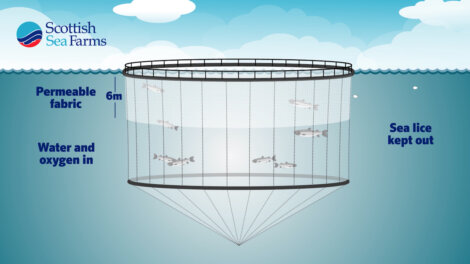News / Sea lice shield produces good results
THE NUMBER of sea lice at a salmon farm in Ronas Voe has reportedly stayed below the required threshold for the last nine months after Scottish Sea Farms trialled a new way of tackling the parasite.
The company introduced a six-metre deep sea lice shield at its farm at Slocka back in May in a bid to combat the issue of naturally occurring lice, which can damage and kill fish.
As well as sea lice levels being kept under control, Scottish Sea Farms also said that salmon at the site are said to be displaying good growth and biological performance.
The shields, or skirts, are formed out of permeable fabric that allow water and oxygen into the cage while keeping lice out.
As a result of the trial, Scottish Sea Farms has now spent £800,000 on shields for 11 of its other farms in Shetland and on the west coast of Scotland.
It is also working with other salmon producers to synchronise the use of the shields thanks to a management agreement in certain areas.
Managing director Jim Gallagher said Scottish Sea Farms was greatly encouraged by the results of the trial.
“We strive, wherever possible, to replicate the natural conditions that salmon are known to thrive in,” he said.
“As any farmer will understand however, this comes with its own risks as the marine environment presents new challenges all the time.
“We are continually exploring and investing in new ways of dealing with these challenges, and it’s hugely encouraging to see positive early results such as these at our trial project in Shetland.”
Professor of aquatic animal health at Stirling University James Bron said the trial could be an important development in tackling sea lice.
“While I can’t comment on this specific technology, sea lice barriers such as those installed by Scottish Sea Farms can provide an important additional tool for the management of sea lice in aquaculture,” he said.
Become a member of Shetland News
“Scottish salmon farms currently employ a strategy of integrated pest management (IPM), which involves use of a diverse range of approaches, including the use of farm management tools, veterinary medicines and physical barriers and removal methods, to control sea lice.
“Most importantly, it is recognised that even small incremental gains achieved by the introduction of new technologies can combine to provide significant improvements in control.”
The shield trial is part of an £11.8 million investment from Scottish Sea Farms in the health and welfare of its fish.
It includes increasing the use of lice-eating ‘cleaner’ fish, net cleaners and ongoing research.
The company also co-funded thermolicer technology to the tune of £4 million, which can dislodge lice thanks to a sudden change in temperature.
Scottish Sea Farms is a member of the Scottish Salmon Producers Organisation, which recently announced that it will begin to release sea lice data on a farm-by-farm basis for the first time.
Become a member of Shetland News
Shetland News is asking its many readers to consider paying for membership to get additional features and services: -
- Remove non-local ads;
- Bookmark posts to read later;
- Exclusive curated weekly newsletter;
- Hide membership messages;
- Comments open for discussion.
If you appreciate what we do and feel strongly about impartial local journalism, then please become a member of Shetland News by either making a single payment, or setting up a monthly, quarterly or yearly subscription.




























































